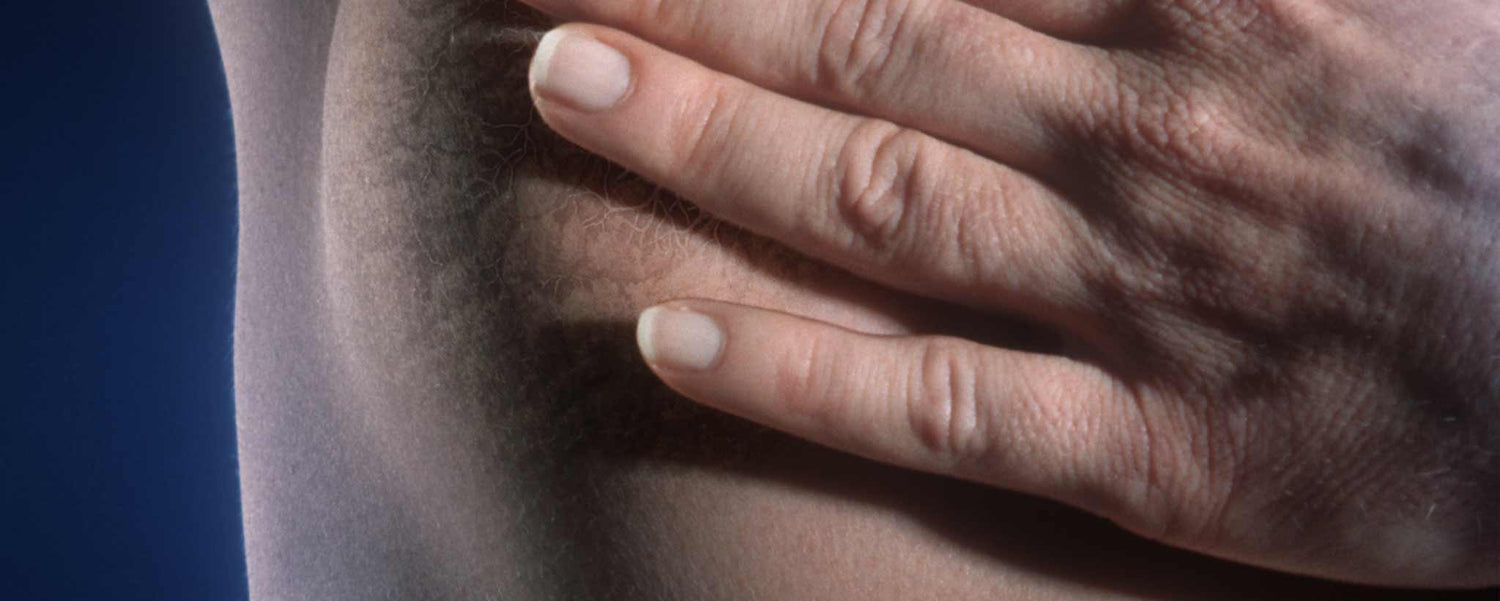During each annual breast cancer awareness month, your goal should be to learn more about this insidious disease than you formerly knew
⚠️ Use Discretion: Graphic human anatomy.
Beyond One Cancer
By a wide margin, more money is spent on breast cancer research per death than on any other form of cancer. [1] Becoming educated regarding prevention, testing, and statistical predisposition improves health and mortality.
In simple terms, cancer is a name for cells that are rapidly dividing without regard for the body. The word “cancer” actually refers to a collection of more than 100 different diseases, such as breast, cervical, or prostate cancer.
It is undisputed that the best way to combat cancer is through early detection. However, it might take weeks to schedule your first appointment after the discovery of a lump. A physician may begin a course of antibiotics for several days to rule out a possible non-bacterial inflammation or monitor whether the lump size abates.
Months can go by before a diagnosis is provided. Time passes while awaiting results from X-rays, ultrasounds, and mammograms. During all this waiting, a patient naturally wonders if more aggressive treatment should have begun sooner.
10 Most Common Cancers
- Skin cancer: 2,000,000
- Prostate cancer: 241,740
- Breast cancer: 226,870
- Lung cancer: 226,160
- Colorectal cancer: 103,170
- Bladder cancer: 73,510
- Non-Hodgkin’s lymphoma: 70,130
- Kidney cancer: 64,770
- Thyroid cancer: 56,460
- Endometrial cancer: 47,130
All values represent 2012 estimates by the ACS. [14] Incidence varies by country. Most tumors are benign. Learn more about cancer funding from the National Cancer Institute.
Off To A Bad Start
It is natural to assume that the moment a lump is detected is when the cancer began—or perhaps just within the interval since the last breast self-examination (BSE). Cell mutations typically take years to manifest themselves as cancer cells. This is why cancer is more common in older people.
A genetic predisposition to a type of cancer or exposure to specific carcinogens may factor into development. By the time a lump can be felt or lesions become manifest within radiology images, years of development have taken place. [2]
Cell mutations typically take years to manifest.
The earliest cancer warning sign may be persistent pain. Next, warts or moles can change color. In some cases, the shape may change too. As the condition worsens, wounds refuse to heal. A sore throat develops, and there is persistent coughing. These symptoms are likely to occur before the discovery of a lump.
Since cancer is abnormal cell growth, advancement is not always linear. Cells can grow slowly over several years, become dormant (remission), and/or rapidly proliferate when malignant. Normal genes multiply during childhood. Multiplication primarily becomes a mechanism for wound repair in adulthood. Oncogenes (cancer genes) multiply constantly.
A backup system called tumor-suppressor genes, like p53, should keep aberrant cells at bay. However, if these suppressors become damaged, cancer cells grow unchecked.
Cancer is a name for cells that are rapidly dividing without regard to the body.
Though cancer is not considered an autoimmune disease, each condition seizes control of the body’s defensive immune system. In patients diagnosed with either disease, these two opposing forces may compound, further complicating treatments and side-effect management efforts.
Men Can Get Breast Cancer Too
Although gynecomastia—abnormal hormonal male breast enlargement—is the most common male breast disorder, male breast cancer is possible, though rare. There are only about 2,000 cases in the United States annually, with 400 male deaths. The incidence of breast cancer in men is 1 percent of that for women, according to the American Cancer Society (ACS). Regardless of gender, chances increase if parents, grandparents, and/or siblings battle breast cancer.

Male gynecomastia
Comorbidities can raise the odds of tumor malignancy. For example, Sjögren’s makes non-Hodgkin's lymphoma 440 percent more likely. [3] Men with such heredity or predisposition should perform regular BSE—especially during October National Breast Cancer Awareness Month (NBCAM). An ultrasound or mammogram may be required if a lump is discovered.
As is the case with many women, male mammograms may be nondiagnostic due to dense tissue. An estimated 66% of premenopausal women, and 25% of postmenopausal women, have breasts that are dense enough to interfere with mammogram accuracy. Studies show that having dense breasts raises the risk of developing breast cancer fourfold to sixfold, primarily because density can obscure tumors. [4]
Sometimes, alternate imaging technologies provide clearer results. A radiologist is trained to look for vascularity within a mass. This indicates that a tumor has a blood supply—an essential characteristic of cancer malignancy. Poor imaging can hinder this assessment.
Breast screening programs produce a high level of false positive results. In pre-publication data, Kheiron Medical Technologies has developed the first deep learning-based software that surpasses the U.S. National Performance Benchmarks for Modern Screening Digital Mammography based on independent multi-center clinical trials. [5]
Where Breast Cancer Begins
Almost 75% of all breast cancers begin in the cells lining the milk ducts and are called ductal carcinomas. Approximately 25% of male breast cancers are lobular carcinoma (cancer that begins in the lobules). Inflammatory breast cancer makes up about 1% to 5% of all breast cancers.
Paget’s disease of the nipple begins within the ducts but spreads to the skin of the nipple. Paget’s disease is more common in men than in women. Other, less common subtypes of breast cancer include medullary, mucinous, tubular, or papillary.
A type of breast cancer that has spread outside of the duct and into the surrounding tissue is called invasive or infiltrating carcinoma. The majority of male breast cancer cases are infiltrating ductal carcinomas (IDC). [6]
During mammography for men or women, nearby lymph nodes along with breasts are commonly x‑rayed for side-by-side comparison by a physician, preferably an oncologist. An examination should take medical history into account. Discovery of cancer in one location raises suspicion for lesions elsewhere throughout the body, so supplemental tests may be required.
Why Cancer Metastasizes
When cancer is confined to one area, removal and prognosis are most favorable. But cancer has atypical properties to encourage spreading or metastases. A growing tumor exerts pressure on adjacent normal body tissue.
This can cause a breach over time. Enzymes that normally break down waste cells and tissues can be used destructively by cancer cells to discard healthy tissue, allowing neoplasms to develop. [7]
Cancer cells also produce a substance that encourages migration. This helps them move through the blood stream or lymphatic system. Some die while traveling. Often, they become trapped within capillaries—the smallest of blood vessels—where growth resumes in a secondary location. Because all blood must be oxygenated, the lungs are a frequent site of secondary cancer. [8]
About 75% of lymph from the breasts drains into the 20–30 axillary lymph nodes, making them important in the diagnosis of breast cancer. Primary breast cancer can migrate to nearby (secondary) lymph nodes, and nodes are a conduit for further systemic migration.
This is why mastectomies generally include the removal of one or more nodes. If lymph nodes are the only place cancer is found beyond the main (primary) site, radical mastectomy surgery to remove the main tumor and several nearby lymph nodes may be able to get rid of it all (and cure it). [9]
Preventing Lymphedema
Removing lymph nodes during cancer surgery can leave part of the body without a way to drain off excess fluid in the affected area. Lymph vessels then run into a dead end where the node used to be, and fluid can back up.
This is called lymphedema, and it can become a lifelong problem, with skin texture changes, swelling, and a more limited range of movement in associated extremities. It is a condition actress Ingrid Bergman suffered with, following breast cancer surgery.
Sentinel biopsy involves injecting dye into the breast lump and seeing which node it first spreads to.
More Americans have lymphedema and lymphatic diseases than AIDS, Alzheimer’s disease, multiple sclerosis, muscular dystrophy, and Parkinson’s disease—combined. A study of 30 unilateral breast carcinoma patients found a 20% rate of developing lymphedema in the axillary lymph node dissection group compared with none in the sentinel lymph node biopsy group.
Rates of lymphedema among women who undergo sentinel lymph node biopsy have been reported to be between 5% and 17%, depending on the diagnostic threshold and length of follow-up. [9,10]
Surgeons are advised to excise as few lymph nodes as necessary. Sentinel biopsy involves injecting dye into the breast lump and seeing which node it first spreads to (the sentinel node). This node is then removed and examined. If there is no cancer present, it is assumed the cancer has not spread. This procedure is often less invasive and less damaging than the axillary lymph node dissection.
Cancer Grows Slowly and Quickly
Even fast-growing tumors require several years to reach sizes that can be detected by medical diagnostic imaging methods. [11] So the answer to the question of how fast cancer grows is that it may take years for cancer to manifest itself or become palpable, but just months to metastasize. Once symptoms become manifest, time should not be wasted unnecessarily. This may allow the opportunity for secondary cancers to form.
It may take years for cancer to manifest itself or become palpable, but just takes months to metastasize.
The only certain way to diagnose a suspect lesion is biopsy. Many radiologists prefer excisional over aspiration biopsy for more definitive evaluation. Lab tests can indicate to professionals how quickly cancer may grow, how well certain treatments may work, and how likely the cancer is to recur.
Tips for Cancer Prevention
Prolonged psychological stress may affect a person’s overall health and ability to cope with cancer. However, no studies support the notion that stress causes cancer. Taking birth control pills for an extended time slightly increases breast cancer risk, particularly in younger women. However, the risk level goes back to normal 10 years or more after discontinuing oral contraceptives. Interestingly, the risk of endometrial and ovarian cancer appears to be reduced with oral contraceptives. [12]
High Cancer Risk
- Sjögren’s disease patient
- Family history of cancer/lymphoma
- Gynecomastia
- Overweight and sedentary
- Heavy alcohol drinker
- Tobacco smoker
- Exposure to carcinogens/radiation
- Female hormone replacement therapy
- Teenage oral contraceptive user
- Fellation or cunnilingus activity
- Lack of regular medical checkups
The Mayo Clinic offers the following suggestions to reduce risk of breast cancer: Limit alcohol; don’t smoke; control weight; be physically active; breastfeed; limit dose and duration of hormone therapy; avoid exposure to radiation and environmental pollution. [13] Most doctors recommend that women perform regular breast self-examinations. Let me know what you think. Is this article helpful, or a bit more than you want to know about cancer?
To support the writing of scholarly articles about oncology, ClinicalPosters sells human anatomy charts, scientific posters, and other products online. You may sponsor specific articles, become a ClinicalNovellas Member, or remit a small donation.
ClinicalPosters sells human anatomy charts, scientific posters, and other products online to offset expense of the writing useful articles about oncology. Slide extra posters into DeuPair Frames without removing from the wall.
Show your support by donating, shopping for ClinicalPins, becoming a ClinicalNovellas Member, or leaving an encouraging comment to keep the research going.
To support the writing of useful articles about oncology, ClinicalPosters sells human anatomy charts, scientific posters, and other products online. You may sponsor specific articles or remit a small donation.
ClinicalPosters sells human anatomy charts, scientific posters, and other products online to offset expense of the writing useful articles about oncology. Slide extra posters into DeuPair Frames without removing from the wall.
ClinicalPosters sells human anatomy charts, scientific posters, and other products online. You may remit a small donation or become a ClinicalNovellas Member.
You can support the writing of useful articles about oncology by sponsoring specific articles, becoming a ClinicalNovellas Member, or remitting a small donation. Visible content is optimized for device size.






 Romance & Health Intertwine. Fall in love with a captivating romance miniseries that explores the essence of well-being. Become a ClinicalNovellas member for heartwarming tales.
Romance & Health Intertwine. Fall in love with a captivating romance miniseries that explores the essence of well-being. Become a ClinicalNovellas member for heartwarming tales.





